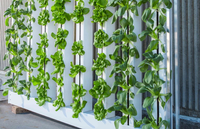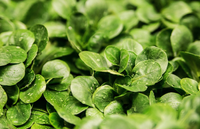What is Vertical Farming?
Vertical farming has become a global trend since the early 2000s. Vertical farming, as the name implies, is the agricultural practice wherein the crops are grown in vertical constructions instead of traditional horizontal farming.
Potential of Vertical Farming
The concept of vertical farming was developed considering the constant population growth on the planet, which in the future would provoke a shortage of agricultural lands. Furthermore, 33% of the world’s degraded soil is due to erosion and it is expected that by 2050 10% of all current agricultural yield will be lost due to erosion. Vertical farming has the potential to provide a large number of the population with local food, and in the process reduce the time & cost of transporting fresh crops from the field to the customer.
Working Principle of Vertical Farming
Vertical farming is an alternative approach to traditional farming. Vertical farming is a common method of growing plants and produce in a vertical orientation, in an indoor environment with carefully controlled conditions and lighting, maximizing the use of land resources. In vertical farming, the crops are grown in vertically stacked layers, inside multi-story buildings or skyscrapers, using artificial lights and nutrients. As crops are stacked vertically on top of each other, the productivity of the farmed surface improves by a factor of four to six as compared to the traditional farmed surface. The idea is to grow crops in vertically stacked layers, inside multi-story buildings or skyscrapers instead of vast horizontal farmlands, as it requires a much smaller area to cultivate the same amount of crops. The bigger and taller the buildings are, the greater number of crops can be cultivated.
Aspects of Efficiency and Sustainability
In vertical farms, the crops inside these greenhouse skyscrapers are grown hydroponically or aeroponically. Hydroponics is the technique of growing plants (without soil) in water containing dissolved nutrients. This technique uses a nutrient-rich solution, allowing the nutrient uptake process of the plants to be more efficient than when using soil. Aeroponics is another plant-cultivation technique generally being used in Vertical farming. It is a technique in which the roots are suspended in the air while the nutrient solution is sprayed onto them in the form of a fine mist. Hydroponics consumes 70% less water as compared to the open-field traditional agriculture. Aeroponics techniques use 70% less water than hydroponics, saving even more water.
The cultivation of the crops in a controlled climate ensures the security of the crops against any climatic changes and a wide range of crops can be cultivated thus making it feasible to increase biodiversity. The vertical farms operate in controlled conditions, such that the temperature, humidity, and lighting are controlled for optimum growth of the crops. Furthermore, having controlled conditions, we can ensure production throughout the year, the use of pesticides and chemicals can be avoided, and the consumption of the water be reduced. Vertical farming has reached a much better prominence in the last few years, and this has been possible thanks to the advancements in hydroponics, aeroponics, and LED technology that is being used as a substitute for sunlight. The buildings operate as a huge greenhouse to maintain and control the environmental variables and ensure improved production, and optimum growth of the crops.
Vertical farming benefits not only the producer, but also the environment, and some of the major advantages are as follows:
Advantages of Vertical Farming
- Maximizes land use for food production: As the population is growing day by day, the demand for food is bound to increase. Furthermore, as the fertile soil has been reduced, the agricultural lands are depleting. No deforestation is required in search of new farmlands as vertical farms are mostly in urban areas, re-using buildings.
- Safe and secure plant growth with low risk of failure: Vertical farming in a controlled environment makes it easier to control the climate, soil, humidity, nutrients supply, weather, and pests, etc. Also, the vertical farms are in urban areas, thus shorter delivery chain and better control. Furthermore, the crops are cultivated inside the buildings, and thus are protected from any adverse environmental conditions, for ex: storms.
- Fresh, organic and diverse plants: Almost any kind of crop can be cultivated with the right controlled conditions, thus making it independent of the season. Also, the crops are free of herbicides, pesticides, and other fertilizers.
- Fast growth rate: The ideal conditions under which the crops are cultivated in vertical farming ensures that the growth rate of the plants will be faster. Also, the plants will have rich nutritional value as compared to traditional crops.
- Protect the environment by conserving the resources: Vertical farming tends to resolve some of the issues related to the use of limited natural resources and land areas. As vertical farming optimally utilizes the land space, it can reduce deforestation and desertification which is carried out in search of new agricultural lands. As compared to traditional farming techniques, vertical farming uses hydroponics or aeroponics techniques, which are far more efficient and helps save water.
Weiterführende Links:





